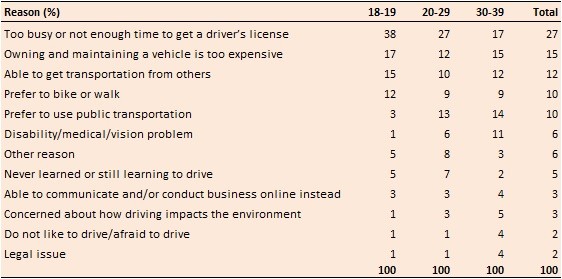
There’s a heap of evidence showing driving is declining in many countries, most especially in the anglophone nations and among the young e.g. see Are millennials driving less? (1).
One of the key indicators of the change is the large increase in the proportion of the population without a driver’s license. For example, in the US the percentage of persons aged 19 years of age who have a driver’s license fell from 87.3% in 1983 to 69.5% in 2010.
There are many potential explanations for this change, but little agreement. Some argue it’s due to smartphones, better public transport, concern about the environment and a growing preference for density; some that it’s all about higher oil prices and the GFC; and others that it’s primarily due to underlying structural social changes.
Some newly published research by Brandon Schoettle and Michael Sivak from the University of Michigan’s Transportation Research Institute provides new data that might help make sense of this question.
They surveyed 618 “young adults” in the US aged 18-39 years who don’t have a license. The key question they put to them was: “What is the MAIN reason you do not currently have a driver’s license?”
I’m wary of on-line surveys however the findings are published in the latest issue of the journal Traffic Injury Prevention under the title, The reasons for the recent decline in young driver licensing in the US. It’s gated, but there’s an open access working paper available here (Australian academics please take note).
Schoettle and Sivak have separately and jointly published a number of papers on the decline in driving. For example, see these journal papers (here, here, here and here). See also these reports published in The Atlantic, including Crash: the decline of US driving in six charts published last Friday.
I don’t have access to the journal version of Schoettle and Sivak’s new paper and the working paper version only gives a brief summary of the methodology. However assuming the methodology is sound, three findings stand out.
First, only 20% of those sampled say they don’t have a driver’s license because they prefer to walk, bike or take public transport; most say it’s because of the difficulty of getting a license and/or the cost of driving.
Just 3.4% proffer “able to communicate and/or do business on-line” as their primary reason for not having a license and just 3.1% say it’s because they’re “concerned about how driving impacts the environment”.
Contrary to some of the rhetoric about younger millennials, members of the older 30-39 years cohort were more likely to be motivated by environmental concerns and a preference for public transport than 18-19 year olds (2). The younger cohort was twice as likely to nominate “too busy or not enough time” as their key reason for being unlicensed.
Second, those without a driver’s license are much more likely to be unemployed than their peers in the wider population.
Schoettle and Sivak say that 46% of their sample were unemployed (not in full or part-time work) compared to 10.5% of the same age group in the US population. In fact only 19% of those without a driver’s licence have a full-time job.
Moreover, only 22% of the sample have completed an associate degree or higher, compared to 37% for the same age group in the national population.
Third, the great majority (78%) “plan to get a driver’s license” at some point. Only 21% say they never intend to get one whereas 43% plan to get a license within 12 months and 69% within five years.
Younger respondents showed the greatest interest in obtaining a license. 90% of 18-19 year olds say they plan to get one within five years. This falls to 70% of 20-29 year olds and to 47% of 30-39 year olds.
The authors say their study wasn’t designed to investigate if there is a causal relationship between licensing and unemployment.
Nevertheless their findings are consistent with a narrative that long-run structural changes in the US economy resulting in low earnings and high unemployment/underemployment among young adults are a key explanation for the decline in driving.
These changes come at a time when other factors (e.g. higher petrol prices) make driving a less compelling proposition for the sub 40 years age group than it was 10 or 20 years ago. Those with limited incomes are nowadays more inclined to spend their money on other things.
It seems though that most anticipate getting a license at some stage in the future, perhaps when their financial circumstances improve enough to make driving a realistic option. If the research is right, it seems economic factors are a large part of the explanation for the decline in driving.
Still, I’m cautious about putting too much weight on one piece of research. In particular, I’m not sure from the working paper if the sample is representative of all 18-39 year olds who don’t have a driver’s license.
Presumably the published paper gives a more fulsome account, but until I’ve had an opportunity to read it I’ll treat the findings as suggestive, not definitive (3).
____________________________________________
- I’ve discussed the fall in car use by Gen Y a number of times before (e.g. here, here, here and here). There’s a long list of possible explanations (e.g. see Why are Australians driving less than they used to?) but not much agreement on what the key ones are.
- Note that the age cohorts differ in size i.e. 18-19 years vs 20-29 years and 30-39 years (although the sample quotas for each one are much the same).
- Update: in the journal version (accepted manuscript) the authors say the “respondents are generally representative of the US population”.








Crikey is committed to hosting lively discussions. Help us keep the conversation useful, interesting and welcoming. We aim to publish comments quickly in the interest of promoting robust conversation, but we’re a small team and we deploy filters to protect against legal risk. Occasionally your comment may be held up while we review, but we’re working as fast as we can to keep the conversation rolling.
The Crikey comment section is members-only content. Please subscribe to leave a comment.
The Crikey comment section is members-only content. Please login to leave a comment.